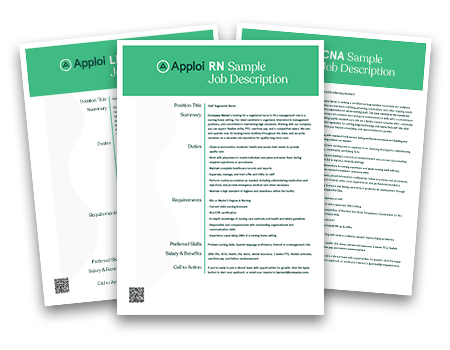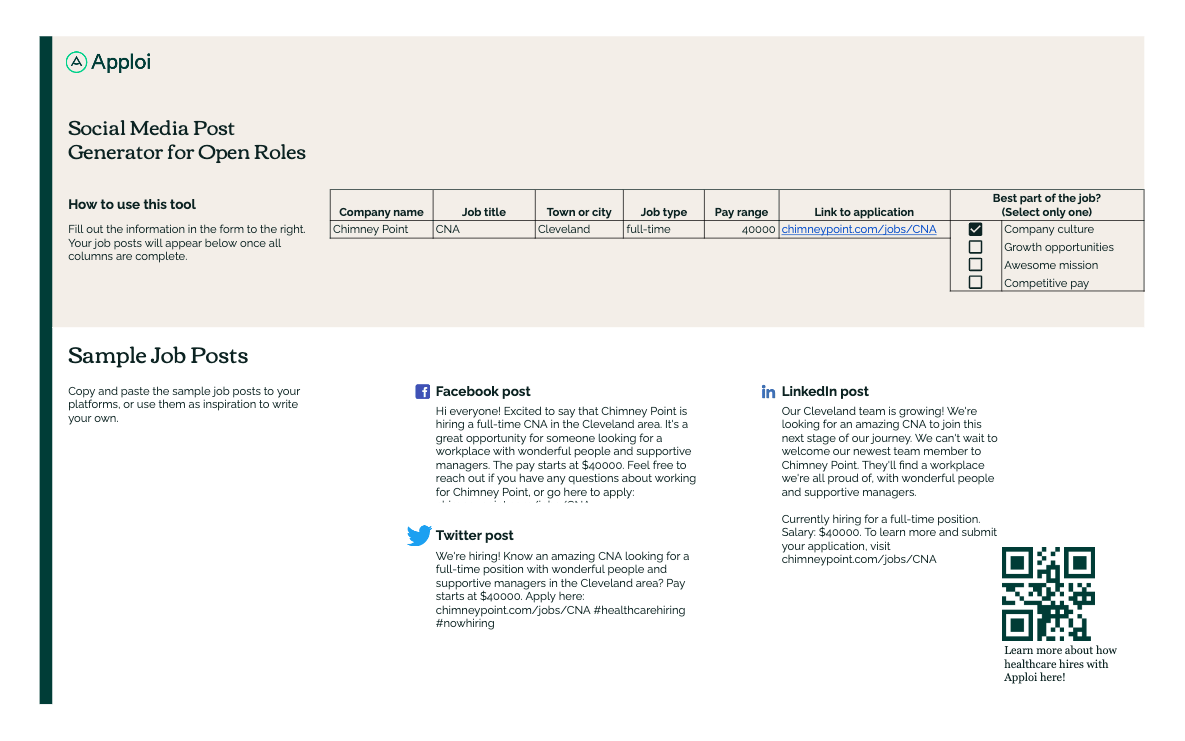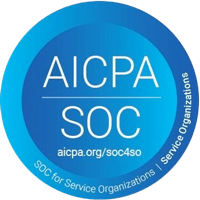10 Hiring Strategies Successful Healthcare Employers Actually Use
Successful healthcare recruitment isn’t a matter of luck. Behind every thriving healthcare business is a winning strategy for recruitment and retention. But not every employer puts their strategy into words—and forget about sharing tips with competitors. We’re here to demystify the tactics that lead directly to growth. We’ve compiled 10 of the most important hiring strategies successful healthcare employers use to help their businesses prosper.

Ideally, a company’s hiring strategy will balance all or many of these approaches. That being said, it can be worth focusing on one recruitment strategy at a time to build your recruiting efforts in a sustainable way.
Here are the top ten hiring strategies used by successful healthcare businesses.
FREE TEMPLATES
Create effective job posts to attract more candidates with our free templates for RN, CNA, and LPN job descriptions
 1. Focus on Speed
1. Focus on Speed
At this point, we all know that many healthcare employers are competing for the same candidates. The healthcare industry is looking at a 3.2 million worker shortage for roles like nursing assistants and home health aides. Competition between employers is inevitable.
So how do successful employers respond to such a difficult situation? By focusing on recruiting faster.
Employers who build hiring strategies around speed rely on one idea: that they can find and hire those coveted candidates before anyone else does.
The trick to this tactic is ensuring you pick up speed without losing quality. Employers can do this by automating certain tasks, asking prescreening questions to weed out unqualified candidates, and using digital hiring software to manage different recruitment efforts from one place.
Tactics for Quicker Recruiting
- Automate hiring workflows and administrative communication with candidates
- Replace (or support) emails with texts, which typically get quicker responses
- Use hiring software to distribute your jobs to job sites automatically
- Schedule interviews immediately upon receiving applications
- Begin tasks associated with onboarding (such as background checks and licensure verification) during hiring
- Use a digital system to manage applications and save important candidate information
 2. Get Social
2. Get Social
Most employers have gone through the experience of posting to job boards, crossing their fingers, reposting, and manually posting to another board. The cycle can feel endless.
But for some employers, job boards aren’t the only (or even the primary) source for online applicants.
Instead, these employers invest in social recruiting. From broadly popular and well-established sites like Facebook and LinkedIn to younger-skewing platforms like Snapchat and TikTok, social media can be a valuable source of candidates.
Benefits of Recruiting Through Social Media
- Social media is mobile-friendly so candidates can view and apply for jobs on the go
- Your followers can reshare your posts, spreading your jobs to people who might not otherwise see them
- While different social media sites are popular with different demographics, overall, these platforms skew toward younger users, helping you find brand new applicants
- Hashtags and keywords increase the likelihood that new candidates will find your posts
 3. Offer Cutting Edge Benefits
3. Offer Cutting Edge Benefits
While competitive salaries are an important factor for job seekers, healthcare employers often have strict limitations on wage increases. That’s one reason some managers use hiring strategies that focus on something they actually can control: unique and desirable benefits.
Applicants seeking full-time employment will likely take it for granted that their employer will provide health insurance. But there are other ways to make your benefits stand out.
Employers who use this hiring strategy want their benefits to be at least one of two things: uncommon and flexible.
Why uncommon? Well, it’s not a competitive strategy if the business down the street offers the exact same perks.
And why flexible? So employees can choose the benefits that work for them, without HR needing to rely on guesswork.
An employee’s benefits package can have a significant impact on their job satisfaction. Flexible and generous benefits make it easier for all employees to maintain a healthy working life, which also has benefits for diversity, equity, and inclusion.
Benefits Competitive Employers Offer
- Onsite daycare
- Reimbursement for childcare
- Commuter reimbursements
- Professional development
- Shift bidding
- Wellness stipends
- Sabbaticals
- Student loan or tuition reimbursement
- Health savings account
- Remote work shifts
- Gym memberships
- Lunch budget
FREE Social Media Job Post Generator
Copy & Paste the perfect job post with our free generator
 4. Build an Unbeatable Culture
4. Build an Unbeatable Culture
Burnout and stress are two of the most common reasons healthcare workers leave their jobs. Naturally, those are also things new job seekers hope to avoid.
Poor company culture can be a huge issue for healthcare businesses. Some successful employers make culture a core piece of their recruiting and hiring strategy.
Building a healthy workplace culture helps both recruiting and retention efforts. When employers have a culture worth bragging about, word of mouth naturally attracts candidates. But employers can also leverage their strong culture in recruiting materials.
Ways to Build Healthy Work Culture
- Limit on shift numbers and lengths
- Maintain trong employee recognition programs
- Check in with teams and supervisors frequently
- Maintain medical safety protections
- Mandate time off
- Support mental health through awareness campaigns and wellness benefit
 5. Hone Your Mission
5. Hone Your Mission
All healthcare businesses serve their communities. But not all businesses make their mission the centerpiece of their hiring strategy.
A mission-based strategy is all about appealing to candidates based on your business’s intention and impact. Employers who pull off this strategy show applicants exactly how they fit into their community, focusing on the material results of their services.
At its best, this hiring strategy can transform some aspects of your open positions from liabilities to assets. For example, candidates might hesitate to work at a rural facility, but feel more compelled by the role when they understand the outsized impact their role would have on the community.
Signs of a Mission-First Hiring Strategy
- Mission statements in job descriptions and on career pages
- Prominent patient and resident testimonials
- Publicly posted workplace values
- Employee recognition programs that reward staff for living up to the mission
- Social media accounts that highlight patients, residents, and results
 6. Create Opportunities for New Workers
6. Create Opportunities for New Workers
The healthcare worker shortage is real, but that doesn’t mean it’s always easy for graduates to find positions. In fact, around 36% of baccalaureate graduates take longer than six months to land a job.
While some employers hesitate to hire recent graduates, others develop successful hiring strategies to target these same candidates. And hiring new graduates comes with a lot of perks. Employers can mentor and train these workers to their business’s exact needs, helping build budding careers. Plus, new graduates are often highly loyal to the first employer who gave them a chance.
They do this in two ways. The first is by contacting healthcare programs directly and inviting applications from recent graduates. The second is by creating a workplace where new workers are supported with ongoing training, social bonds, and meaningful mentorships.
How Employers Can Recruit and Support New Healthcare Workers
- Provide in-house training
- Recruit directly from academic programs
- Offer mentorships that connect new workers and seasoned ones
- Develop buddy programs to ensure new workers have social support
- Initiate and support worker affinity groups
 7. Look to Your Existing Employees
7. Look to Your Existing Employees
For employers who already have large and engaged workforces, existing staff can be a great source of new candidates.
This hiring strategy has two parts: internal hiring and employee referrals.
Promoting and hiring from within has some distinct advantages. When employees grow together, they’re more likely to share feelings of kinship, respect, and mutual encouragement, even if they develop into completely different career paths.
Employees who expect to be promoted are also often more invested in their workplace, resulting in better work and lessened turnover. An internal hiring process also signals to new candidates that you’re willing to invest in them.
Of course, internal hiring needs to be paired with other recruitment avenues to fill the vacancies left by employees who move to different roles. That’s where employee referrals come in. Encourage your employees to refer their friends, and reward successful referrals with bonuses or other incentives.
 8. Develop a Talent Pool
8. Develop a Talent Pool
Not all employers start recruiting from scratch every time they have an open role. In fact, for businesses with sizable talent pools, it might not be necessary to find new applicants at all. Instead, these employers can sort through their records and rehire past workers or reengage former applicants.
This strategy requires meticulous records of all the workers and candidates who have ever passed through your business. In general, talent pool-focused hiring strategies are most successful for employers who use digital recordkeeping tools to store employee and applicant data.
How Employers Can Build a Healthcare Talent Pool
- Hold onto records of past applicants and former employees in a secure online storage system
- Establish a newsletter with updates about your facility, including professional opportunities
- Encourage visitors to your career page to subscribe to your newsletter
- Invite visitors to submit their resumes, even if you’re not actively hiring for their roles, so you’ll have it on hand in the future
- Build a social media platform or blog with information that appeals to healthcare workers, and use these platforms to solicit applications
- Store resumes in an ATS or internal resume library
- Reach out to former employees and applicants frequently to check if they’re seeking new opportunities
- Maintain good relationships with former applicants by providing automated thank you notes and feedback, even for candidates who don’t get a job offer
 9. Multi-Channel Recruiting
9. Multi-Channel Recruiting
Multi-channel recruiting is a hiring strategy that focuses on sourcing candidates from multiple places at once.
This hiring strategy goes beyond cross-posting jobs to multiple job boards. It can also include recruiting on social media, in person, through networking, with employee referrals, and with analog ad campaigns.
Recruiting from multiple channels can help employers find more candidates, but it can also make job applications more accessible for applicants themselves. Digital job ads are valuable, but they’re not a good way of finding candidates who don’t have wifi access or mobile data.
Consider this: 97% of Americans own a cellphone, but only around 85% use a smartphone specifically. Multi-channel recruiting, which can include texts and local ads, is generally a much more inclusive hiring strategy than relying solely on job boards.
Sources for Multi-Channel Recruiting
- Text message campaigns to previous candidates, requesting new applications
- Social media platforms like Instagram, TikTok, Reddit, Twitter,
- Ads on local radio
- Open interview and in-person hiring events
- Flyers
- Billboards
- Vinyl car wraps
- Television ads
- Paid Google ads
- Job fairs at local schools
 10. Double Down on Employer Branding
10. Double Down on Employer Branding
Finally, some businesses appeal to candidates by leaning into employer branding.
But what is employer branding? Essentially, it’s your reputation as an employer. If potential candidates decide not to apply to your roles based on negative Glassdoor reviews or unprofessional messaging, that’s a branding problem.
But the opposite is also true. Attractive career pages, glowing company reviews, and positive news items can all help establish you as an employer of choice.
No one can entirely control their reputation, but you can strengthen yours by improving your job ads, your communication with candidates, and by putting the spotlight on employee testimonials.
Tips to Strengthen Employer Brand
- Write clear, informative job descriptions, including transparent information about compensation and benefits
- Maintain an attractive website, and perform routine checks for outdated content and broken links
- Feature employee testimonials on your career landing pages
- Respond to all applications with courteous and gracious responses, even if they’re not the candidate you’re looking for
- Highlight your culture on social media to help show why you’re a great place to work
- Let current employees know you’re trying to increase your profile on Glassdoor and similar sites (but be careful—never bribe or require workers to leave positive reviews)
- Invite your most involved workers along to job fairs and recruiting events so they can speak to candidates directly about their workplace
Better Hiring With Apploi
Understanding the best healthcare hiring strategies is one thing. Putting them into practice is another.
Using Apploi’s human capital management software, you’ll be able to hire faster with automated workflows, communicate effectively with unlimited texts and emails, store files safely, and improve your reputation with attractive branding.
Interested in learning more about how you can recruit, hire, and onboard healthcare staff quickly? Contact us today for a free demo of our human capital management solution.



